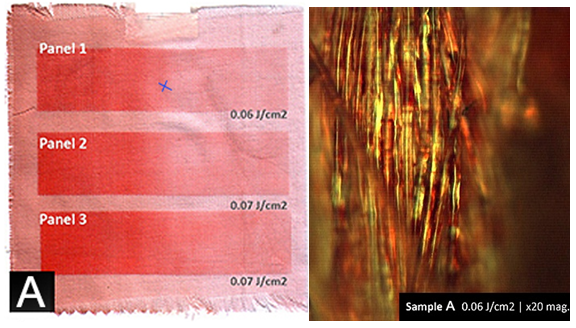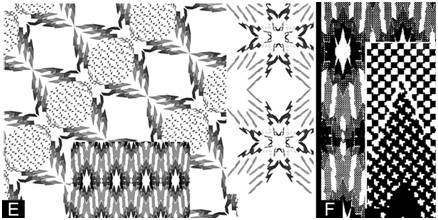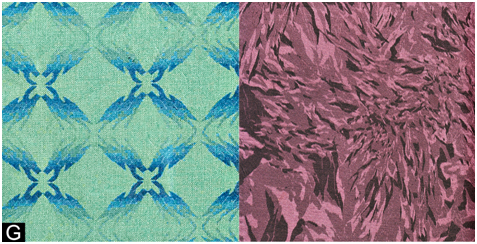Journal of
eISSN: 2574-8114


Research Article Volume 2 Issue 3
School of the Arts, Loughborough University, UK
Correspondence: Kerri Akiwowo, Textiles: Innovation & Design, School of the Arts, Loughborough University, Epinal Way, Loughborough, Leicestershire, LE11 3TU, UK, Tel 4 4015 0922 8311
Received: May 25, 2017 | Published: July 28, 2017
Citation: Akiwowo K, Kane FE, Tyrer JR, et al. CO2 laser dye patterning for textile design and apparel manufacture. J Textile Eng Fashion Technol. 2017;2(3):394-399. DOI: 10.15406/jteft.2017.02.00061
A digital dyeing technique, described as ‘Digital Laser Dyeing’ (DLD) was studied in this research using CO2 laser technology, synthetic textiles, workshop coloration methods and industry standard dyes and dyeing procedures. Laser beam energy was used as an image creation tool to modify surface fibres with graphic patterns and coloured dyed effects through a Computer Aided Design (CAD) approach. The research was supported by a textile design perspective in order to explore the creative potential of DLD methods for textile processing, fabric finishing, fashion design and apparel manufacture. Combined technical and scientific inquiry ensured experimental rigor in terms of the repeatable methods employed and reliable results achieved using an energy density (J/cm2) approach. Outcomes of the study identified CO2 laser-dye patterning as an innovative alternative textile coloration approach and dye on demand manufacturing process relevant to textile and clothing production. Explorations with polyester/elastane sportswear and intimate garments in this study suggest a potential sector for the development of on demand processing for synthetic textiles and clothing.
Keywords: co2 laser technology, energy density, synthetic textiles, textile design, textile coloration, textile patterning; digital laser dyeing, demand processing, sportswear, apparel manufacture
DLD, digital laser dyeing; CAD, computer aided design; FDL, fibre dye laser; IR, infrared; FLD, fibre laser dye; SDC, society of dyers and colourist
Laser technology used in materials processing has been widely documented. Within a textile engineering context regarding synthetic fabrics, laser technology can modify surface fibres through laser beam interaction as studied by: Shahidi & Wiener1 Lau et al.2 Bahtiyari3 Kan4,5 Shahidi et al.6 Nourbakhsh & Ebrahimi,7 for example. This interaction changes the physical material properties of synthetic fibres such as polyester (PET), altering the polymeric molecular chains of substrates. In this manner, benefits to dyeing synthetic materials have been realised due to the increased dye uptake capability of laser treated textiles and substrates which are traditionally difficult to dye, as documented by: Aspland.8 In particular, their ability to yield dark and deep shades conventionally. As such, synthetic textiles are intensive resources using traditional coloration methods requiring large amounts of energy and water usage with the addition of solvents. Alternatively, laser technology is a low energy, dry, and efficient approach to textile processing. The CAD aspect of the technology facilitates creative development of the laser-dye process studied in the ability to combine textile engineering with textile design. This has been achieved by utilising the laser as a digital patterning tool with dyes and computer generated graphics that were marked onto the fabric surface via laser beam energy. Until more recently in this field, as documented by Akiwowo9,10 Bartlett11 Addrison12,13 Morgan14 designed effects like this have only been achievable using textile printing processes. This research explored an energy density (J/cm2) approach to enable creative expression of the laser-dye process in a controlled way. A practical understanding regarding the number of Joules of energy per square centimetre (J/cm2) generated across the fabric surface in terms of laser beam output made it possible to determine specific shades and tonal variability on the textile surface during the dye uptake stage. As a result, a reliable method was established and replicable coloration/patterning effects were achieved. Atomization of the technology facilitated precision processing, relevant to design and technical proficiency of techniques involved. In contrast, the results can be repeated and the creative, technical and scientific data documented and embedded in the textiles and prototype garments is transferrable for [re]production purposes.
Textile materials
Two standardized (ISO) polyester fabrics were used in the study as detailed in Table 1-one plain weave constructed by interlacing yarns; and one knitted jersey constructed by inter-looping yarns. This variant facilitated the transferability goals of the laser-dye process by understanding laser parameters that were either the same or unique to each textile type. The woven PET textile consisted of a 100% polyester staple fibre, whilst the knitted textile contained 3% elastane or ‘spandex’ compared to 97% polyester substrate. Characteristically, the woven polyester was therefore more rigid in terms of extension. The composition of the weave structure meant the fabric was flat and firm, with good dimensional stability. Subsequently, apart from diagonal elasticity achieved on the bias, the fabric had minimal stretch properties. In contrast, the presence of elastane in the knitted polyester gave the fabric stretchiness. This was further aided by the inter-looping structure of the knitted fabric which facilitated extension and stretch characteristics. In addition, knitted garments are typically form-fitting and easily shape the human contour by gliding and hugging the body unlike plain woven fabrics. Although the DLD process was explored with both woven and knitted textiles, sportswear garments appropriately demonstrate the potential for development regarding active apparel using knitted polyester/elastane varieties, which is commercially relevant in terms of sportswear and intimate apparel markets.
S. No. |
Fabric |
Supplier |
Composition |
Construction |
a |
Polyester |
Society of Dyers and Colourists (SDC) |
100% Polyester staple fibre (undyed) |
1/1/ Plain Weave: Warp: 23,5 per cm, Weft 20,5 per cm; Yarn: Warp: 7,5tex Z 1000×2 S 800; R 15 tex, Weft: 20 tex S 800 |
b |
Polyester |
Crystal Martin |
97% Polyester, 3% Elastane (piece dyed off-white) |
Single Jersey Knit: 28 gauge, 17Dex 180 gm per sqm2; 57 courses,-3cm, 49 wales-3cm |
Table 1 ISO Polyester fabrics used in this research
Each fabric neither hindered nor enhanced the visual appearance of laser dyed/patterned fabrics as it was possible to adjust processing parameters in a controlled manner for optimum results. For example, due to the bulk properties of the knitted polyester, increased energy density was sometimes required to penetrate fibres more deeply through laser beam interaction depending on the detail and intricacy of individual patterns and designs.
CO2 Laser machine
A 10 Watt Synrad laser marker system was employed to conduct the research. This machine has a galvanometer mirror driven system used for marking textiles. In the system, the laser beam is directed by oscillating mirrors. The computer software, Win Mark Pro, enabled the creation of mark files such as graphic objects used to generate imagery i.e. shapes, lines and text; in addition to imported CAD files containing other creative elements. Incremental and variable laser parameters used to process fabrics was supported by the computer software.
Textile coloration and patterning procedures
Two main coloration/patterning procedures were carried out in this research:
Workshop approach: Involving hand methods by manually applying industry standard dyes to fabrics before laser marking, termed ‘Fibre Dye Laser’ (FDL) interaction. Industry standard disperse dyes were pasted out or diluted with deionized water. Some specimens contained solvents in addition. The dye solution was then hand painted onto the fabric surface with a paint brush and left to air dry before laser processing. Following FDL interaction, specimens were washed using domestic laundering methods before analysing the results.
Industry standard approach: Involving ISO fabrics, dyes, dyeing procedures and after treatment. Fabric samples were laser marked first then dyed with disperse dyes using a Coloursmith infrared (IR) sample dyeing machine. This method is referred to as ‘Fibre Laser Dye’ (FLD) interaction in this research. 0.4% dye stock solutions were measured and transferred to individual metal beakers for loading into the IR machine together with the sample. Once loaded, the pre-programmed dyeing cycle for polyester was activated. During the cycle, the dye liquor reached 140˚C aligned with the glass transition phase (Tg) for polyester which ensured sufficient dye-to-fibre adsorption. After dyeing, selected specimens were after-treated in a solution containing sodium hydrosulphite/hydroxide for reduction clearing to remove any unabsorbed dye from the fabric surface. Samples were then washed using a Roaches Washtech machine and methods-BS EN ISO 105-CO6/B2S:2010.
Dyes and auxiliaries: The disperse dyes used in this study supplied by Itochu Group, made available by the Society of Dyers and Colourist (SDC) include Dispersol or ‘Itosperse’: Yellow 3G; Yellow Brown SERL (150%); Rubine CGL (150%); Red 2BE (200%); Blue 3RL (150%); and Navy CD2G (200%). Auxiliaries included in the dye liquor were: acetic acid for ensuring the correct pH of 4.5 in a dye bath; Itosolt mend levelling agent (0.5%) to ensure or uniform dyeing; Itoquest LJ3-12 cheatling agent (0.5%) to help with impurities in the water; and LJ550 dispersing agent (0.5%) used to stop dyes from agglomerating.
CAD Technology: CAD technology was used to combine digital design with digital laser processing systems. Original artwork was developed into design work using creative CAD software: Adobe Photoshop and Adobe Illustrator. Design files were exported and converted into an appropriate image mode via Win Mark Pro laser software. This moderation made it possible to mark fabrics using a patterning approach or create an all over laser processed non-patterned effect. Raster and vector marking approaches were explored. Raster processing facilitated a ‘filling in’ pictorial or shape based technique (Figure 1) for generating patterns through closely spaced parallel beam scanning. This was initiated at the design stage using Adobe Photoshop which facilitates the creation and development of ‘digital pictures’. Vector marking techniques were possible using a linear approach to generating design files from a series of specified linear grids (Figure 2) rather than a shape or image method, as with the raster approach.

Micrography: Microscopes were used to further analyse laser dyed fabrics and provide a better understanding about the surface morphology of laser treated polyester in relation to dye uptake via patterned and non-patterned surface effects. Close view observations were carried out at x10.100; x20; and x40 magnification using a Nikon Optishot camera. Microanalysis undertaken involved capturing digital photographic micrographs linked to the computer software which operated the equipment.
Demonstration of the digital laser dye process for apparel manufacture: In order to demonstrate the potential of the laser-dye process using synthetic fibres, sportswear and intimate apparel were identified as appropriate textile goods for potential development of the process within an apparel manufacture context. The following pre-processed ‘white’ prototype garments were studied (Figure 3):
FDL: Fibre dye laser coloration and patterning approach
By using an FDL approach combined with hand and workshop methods for applying dyes to fabric samples; it was possible to ‘stain’ rather than dye the pre-processed textile fibres when brushing the dye solution onto the fabric. To stabilise dye uptake, introducing the laser beam as an additive process enabled dye adhesion on the fabric due irradiation via fibre/laser interaction. Laser energy from the beam activated the dye causing individual fibres to adsorb dye particles. Explorations with CAD patterns and flat colour effects were investigated. Selected fabrics treated in this way were further analysed using microscopy.
Fabric sample A (Figure 4), was hand painted with a 0.05g Red 2BE dye/100ml water solution in a gradient effect-a more concentrated application of the liquor on the left, getting progressively weaker or less saturated on the right side. Once dry, the sample was laser modified via raster method, with two different energy densities represented by three horizontal panels: (1): 0.06 J/cm2; (2): 0.07 J/cm2; and (3): 0.07 J/cm2. The migrograph/x20 magnification (on the right/Figure 4: panel 1 observation) shows the effect of dye uptake on individual PET yarns. The image reveals a ‘speckled’ effect likened to conventional ‘pixels’ or ‘dots’ (i.e. dots per inch/DPI) used to build and communicate digital images and forms within CAD concerning printed approaches. It is also understood that this uneven effect on the yarns can be attributed to the hand application of dyes to surface fibres limiting uniform dye adsorption due to a manual approach.

Samples B1 and B2 (Figure 5) show a before and after washing result. As with sample A, a dye solution was hand brushed on to the fabric surface. Three different solvents were included-one solvent per liquor solution-0.5g Methanol (1); 0.5g Ethanol (2); and 0.5g Acetone (3). The purpose of this experimentation was to investigate whether the solvent positvely aided dye adhesion. After laser processing, part of the specimen was washed. In doing so, a brighter blue shade was revealed in all panels compared to the unwashed specimen. Additive laser processing in this instance activated the dyes through irradiation creating a truer representation of the dye colour; Cetyl Blue BN. Figure 6 demonstrates the development of a patterning approach using a gradient coloration method and repeat designs created in Adobe Photoshop.
FLD: Fibre laser dye coloration and patterning approach
Using an FLD approach, further pattern exploration and development involved the employment of a monochromatic ‘Greyscale’ system for constructing tonally varied patterns in Adobe Photoshop. Percentages of black (GS %) in the form of engineered repeat patterns were generated to achieve a collection of high resolution graphic textile designs from a combination of grey elements (Sample E/Figure 7). Each grey/percentage of black correlated to a specific energy density. It was therefore possible to modify surface fibres in a controlled and automatized way via integrated CAD systems. To laser modify fibres with a raster beam scanning approach, pattern files were converted to ‘Halftone’ in the Win Mark Pro software (Sample F/Figure 7). Figure 8 shows two DLD textile designs using woven PET and FLD techniques. Both deep and pale tones are depicted in each sample corresponding to a range of energy densities and modification levels in laser processing.


Figure 9 demonstrates capability of the laser dye process as a tool for incremental non-patterned dye uptake or flat colour using a vector grid approach. As the line spacing distance increased (from 0.2mm-0.24mm), paler dye uptake was observed due to an increase in the distance between each parallel beam scan and so reduced fibre-laser interaction, which can be understood.

Apparel demonstration
Exploration with knitted polyester fabrics inspired a sportswear and intimate apparel direction whereby complex garment design, fit and customisation aspects linked to consideration of digital laser dyeing as an on demand process for garment coloration and finishing through textile design and in apparel manufacture. Figure 10 illustrates the creative planning involved in the decision making process regarding the placement of engineered designs. Figures 11-13 demonstrates capability of the laser dye process through prototype garments.
In this research, a Digital Laser Dye process, simply referred to as ‘DLD’ or ‘Laser dyeing’ was studied. The process enabled textiles and garments to be designed and finished with high resolution computer graphics using CO2 laser technology, CAD methods and dyeing practices. Two approaches were studied involving hand/workshop and industry standard procedures-Fibre Dye Laser (FDL) and Fibre Laser Dye (FLD) interactions. The DLD method investigated demonstrates the ability to process textiles and garments in this way relevant to textile design and apparel manufacture by using innovative textile coloration and patterning techniques. In this manner, the research has identified the capability and potential of laser technology as both a creative and a manufacturing device by enabling and promoting: laser dyed graphics onto synthetic fabric; high resolution engineered colour and pattern; design innovation; design flexibility; enhanced textile finishing and customisation possibilities; and on demand processing in terms of: pre-laser modified fabric or apparel; post-construction dye on demand finishing for textiles and whole/complex garments; dye to order and dye to specification approaches; low energy consumption due to implementing CO2 laser machines; low or no chemical usage in processing and therefore environmental advantages; lower production costs due to a ‘demand’ rather than bulk production approach i.e. minimum waste; greater aesthetic flexibility based on creative needs and requirements; and rapid production times. Such factors promote efficiency and sustainability regarding the design and manufacture of textile and apparel goods using a DLD approach.
This research was funded by the Arts and Humanities Research Council. The study was collaboration between Loughborough University and industrial project partner, the Society of Dyers and Colourists.
The work carried out was supported by apparel manufacturer, Crystal Martin International and multidisciplinary consultancy, Colour smith Ltd.
Author declares there is no conflict of interest publishing the article.

©2017 Akiwowo, et al. This is an open access article distributed under the terms of the, which permits unrestricted use, distribution, and build upon your work non-commercially.